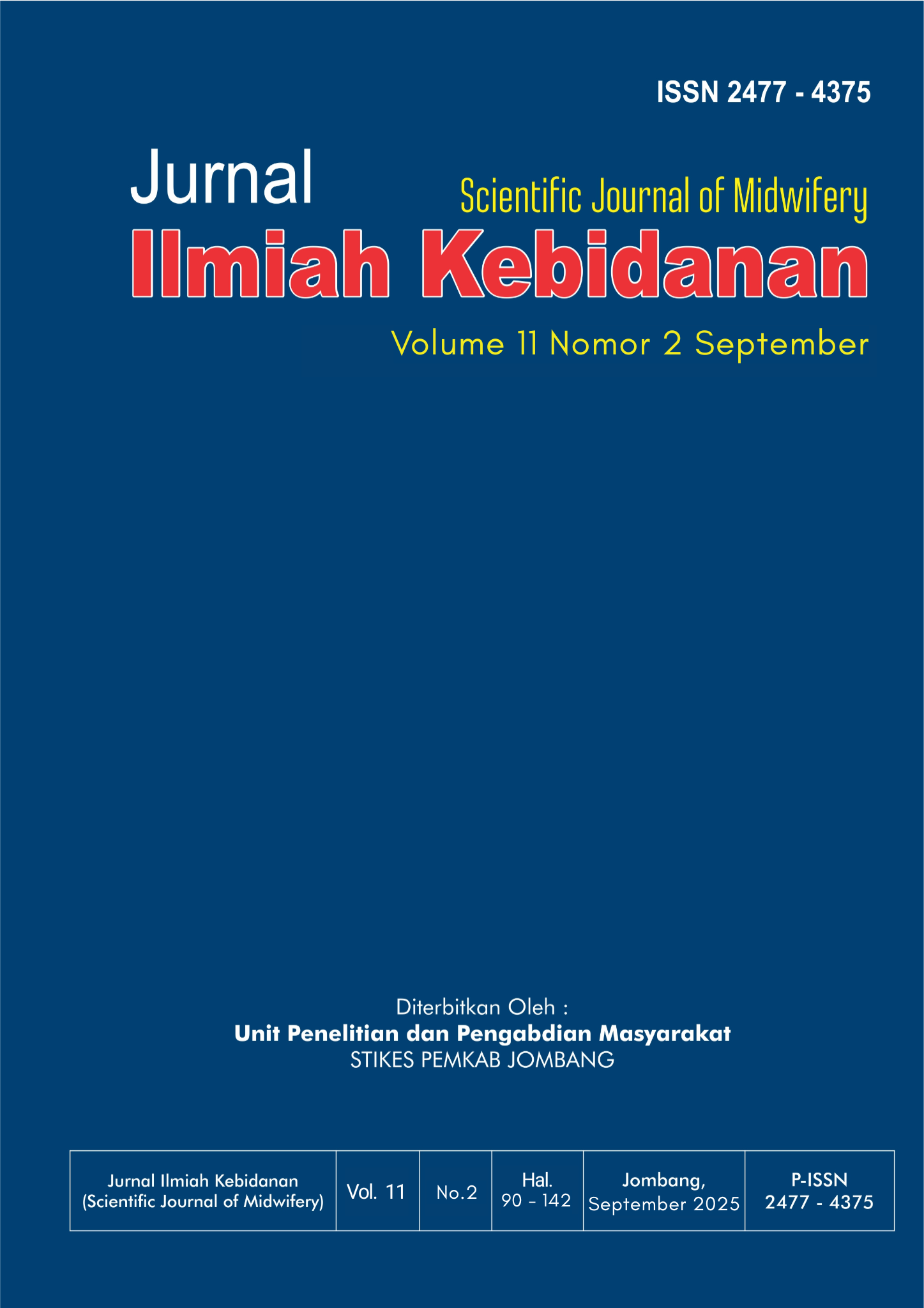FAKTOR-FAKTOR PENENTU PERKEMBANGAN EMOSIONAL PADA ANAK
Factors Determining Emotional Development In Children
DOI:
https://doi.org/10.33023/jikeb.v11i2.2898Keywords:
perkembangan emosi, anak Indonesia, status gizi, paparan layarAbstract
Emotional development is a crucial aspect of child growth that determines long-term mental health, social competence, and academic achievement. Screen exposure and nutritional status are key modifiable factors that may influence children’s socio-emotional outcomes, yet limited evidence exists regarding their combined effects in urban Indonesian settings. A cross-sectional study was conducted in Padang City, Indonesia, from January to July 2025, involving 56 children aged 5–10 years. Emotional development was assessed using a validated questionnaire (Cronbach’s alpha = 0.87). Screen exposure was categorized as ?2 hours/day or >2 hours/day based on caregiver reports. Height-for-age and weight-for-age were measured using WHO Anthro software. Data were analyzed with Chi-square tests and multivariate logistic regression to identify predictors of emotional development. Among the participants, 67.9% had screen exposure >2 hours/day, 26.8% had abnormal height-for-age, and 32.1% had abnormal weight-for-age. Overall, 30.4% demonstrated poor emotional development. Multivariate analysis showed that screen exposure >2 hours/day was significantly associated with poor emotional development (AOR = 4.84; 95% CI: 1.37–17.14; p = 0.014). Abnormal height-for-age (AOR = 3.76; 95% CI: 1.04–13.53; p = 0.043) and abnormal weight-for-age (AOR = 3.42; 95% CI: 1.02–11.42; p = 0.048) were also independent predictors. Sex was not significantly associated. Excessive screen exposure and abnormal nutritional status were significant determinants of poor emotional development among children in Padang City. Interventions should prioritize parental regulation of screen use, promotion of interactive play, and nutritional improvement strategies. Collaborative efforts between families, schools, health professionals, and policymakers are essential to enhance children’s socio-emotional well-being.
Downloads
References
Denham, S. A. (2006). Social-emotional competence as support for school readiness: What is it and how do we assess it? Early Education and Development, 17(1), 57–89.
Thompson, R. A. (1994). Emotion regulation: A theme in search of definition. Monographs of the Society for Research in Child Development, 59(2–3), 25–52.
Moffitt, T. E., Harrington, H., Caspi, A., et al. (2007). Depression and generalized anxiety disorder across childhood and adolescence. Journal of the American Academy of Child & Adolescent Psychiatry, 46(12), 1503–1514.
Black, M. M., & Dewey, K. G. (2014). Promoting equity through integrated early child development and nutrition interventions. Annals of the New York Academy of Sciences, 1308(1), 1–10.
Strasburger, V. C., & Hogan, M. J. (2013). Children, adolescents, and the media. Pediatrics, 132(5), 958–961.
Twenge, J. M., & Campbell, W. K. (2018). Associations between screen time and lower psychological well-being among children and adolescents. Preventive Medicine Reports, 12, 271–283.
Madigan, S., Browne, D., Racine, N., et al. (2019). Association between screen time and children’s performance on a developmental screening test. JAMA Pediatrics, 173(3), 244–250.
Putra, D. L., Asriati, T., & Yuliana, N. (2022). Parental monitoring and screen use behavior among children in Padang, Indonesia. International Journal of Public Health Science, 11(4), 1223–1230.
Ministry of Health Republic of Indonesia. (2019). Basic Health Research (RISKESDAS) Report 2018. MoH.
Prado, E. L., & Dewey, K. G. (2014). Nutrition and brain development in early life. Nutrition Reviews, 72(4), 267–284.
Wachs, T. D. (1995). Relation of mild-to-moderate malnutrition to human development: Correlational studies. Journal of Nutrition, 125(8 Suppl), 2245S–2254S.
Walker, S. P., Wachs, T. D., Grantham-McGregor, S., et al. (2011). Child development: Risk factors for adverse outcomes in developing countries. The Lancet, 378(9799), 1325–1338.
Rahmawati, R., Rachmalina, R., & Hardinsyah, H. (2019). Stunting is associated with socio-emotional problems among Indonesian children aged 3–5 years. Asia Pacific Journal of Clinical Nutrition, 28(3), 575–581.
Guerrero, M. D., Barnes, J. D., Chaput, J. P., et al. (2019). Screen time and problem behaviors in children: A systematic review. Journal of Developmental & Behavioral Pediatrics, 40(7), 519–529.
Indonesian Pediatric Society. (2021). Urbanization and child health: Challenges in major Indonesian cities. Paediatrica Indonesiana, 61(2), 110–117.
Linebarger, D. L., & Vaala, S. E. (2010). Screen media and language development in infants and toddlers: An ecological perspective. Developmental Review, 30(2), 176–202.
Przybylski, A. K., & Weinstein, N. (2017). A large-scale test of the Goldilocks hypothesis: Quantifying the relations between digital-screen use and the mental well-being of adolescents. Psychological Science, 28(2), 204–215.
de Souza, M. J., Stull, A. J., Slater, J., et al. (2019). Nutritional status and neurodevelopmental outcomes: A neuroimaging perspective. Nutritional Neuroscience, 22(11), 789–802.
Grantham-McGregor, S., Cheung, Y. B., Cueto, S., Glewwe, P., Richter, L., & Strupp, B. (2007). Developmental potential in the first 5 years for children in developing countries. The Lancet, 369(9555), 60–70.
Lozoff, B., Beard, J., Connor, J., Felt, B., Georgieff, M., & Schallert, T. (2006). Long-lasting neural and behavioral effects of iron deficiency in infancy. Nutrition Reviews, 64(5 Pt 2), S34–S43.
Chaput, J. P., Gray, C. E., Poitras, V. J., Carson, V., Gruber, R., & Olds, T., et al. (2016). Systematic review of the relationships between sleep duration and health indicators in school-aged children and youth. Applied Physiology, Nutrition, and Metabolism, 41(6 Suppl 3), S266–S282.
Lauricella, A. R., Wartella, E., & Rideout, V. J. (2015). Young children’s screen time: The complex role of parent and child factors. Journal of Applied Developmental Psychology, 36, 11–17.
Published
How to Cite
Issue
Section
Authors who publish with Jurnal Ilmiah Kebidanan (Scientific Journal of Midwifery) agree to the following terms:
- Authors retain copyright and grant Jurnal Ilmiah Kebidanan (Scientific Journal of Midwifery) the right of first publication with the work simultaneously licensed under a Creative Commons Attribution 4.0 International License that allows others to remix, adapt and build upon the work with an acknowledgment of the work's authorship and of the initial publication in Jurnal Ilmiah Kebidanan (Scientific Journal of Midwifery).
- Authors are permitted to copy and redistribute the journal's published version of the work (e.g., post it to an institutional repository or publish it in a book), with an acknowledgment of its initial publication in Jurnal Ilmiah Kebidanan (Scientific Journal of Midwifery).







 This journal (p-ISSN : 2477-4375; e-ISSN : 2477-4383) is licensed under a
This journal (p-ISSN : 2477-4375; e-ISSN : 2477-4383) is licensed under a 